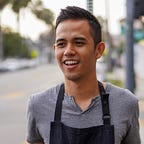A Portrait of Philippine Coffee
There is hope and potential for Filipino coffee producers. This is a portrait of Mang Onda. As my friend Zee has described to me, Mang Onda scratches his head like this when he’s shy. He is one of Zee’s favorite coffee farmers. Zee works with coffee producers like Mang Onda in the Talaan-dig Kalatunganon tribe of Bukidnon, Mindanao. At 1550 m.a.s.l. (meters above sea level), Mang Onda grows a unique heirloom varietal of Arabica known to the community as Kalasan Sweet coffee.
Quality Coffee from the Philippines
Zee’s remarkable work with Filipino coffee farmers is a great example of how the quality of Philippine coffee continues to improve, and how production can grow and reach markets around the globe. As long as I’ve worked in coffee as a Barista, I’ve been championing Zee’s coffee as a prime example of quality coffee from the Philippines. It’s been praised by specialty roasters and green buyers for it’s sweetness, clean body and mellow fruit attributes. In addition, her coffee’s development solidifies the notion that Philippine coffee can meet industry standards. I’ve tried Zee’s coffee harvest after harvest for the past three years -expressed in various roast styles from dark to light- and the coffee keeps getting better.
How Philippine Coffee Inspires a Barista
Zee’s coffee has inspired me in different ways. It has inspired me to be a better Barista. It has inspired me to search within myself for answers to the many inquires I have about coffee, origin, and business in the Philippines’ agricultural sector. It has inspired me to share a vision that might resonate with like-minded individuals.
Most of all, Zee’s coffee has inspired me to dream confidently in knowing there is a future for Philippine coffee and to seek answers beyond what is readily available.
Questions to be Explored in 2017
As the year comes to a close, I would like to express my intention to delve into research around this unique origin with hopes of bringing thoughtful attention to the Philippines as a viable coffee origin for quality coffee.
In the New Year, I seek to ask and understand the following:
1. How can we effectively and sustainably grow the production of Philippine coffee, while engaging the right government partners?
2. How can we best optimize engagements with the international coffee community?
3. How do we disrupt negative stereotypes around emerging origins in Southeast Asia?
4. How can Philippine coffee be best experienced by industry leaders?
5. What is the tradition of Philippine coffee rooted in and how can it best be shared with the rest of the world?
While the questions raised are merely raw attempts to scratch the surface of the many layers of Philippine coffee, I intend to dig deeper and illustrate a vivid portrait that speaks of truth and quality to coffee consumers and professionals around the world.
For now, I leave you with this portrait of Mang Onda, a Filipino coffee producer from the tribe of Talaan-dig Kalatunganon in Miarayon, Bukidnon. He is an endearing man who scratches his head when he’s shy and produces excellent coffee from a country that I proudly refer to as home.
